Estimating the Effects of Natural and Anthropogenic Activities on Vegetation Cover: Analysis of Zhejiang Province, China, from 2000 to 2022
Abstract
1. Introduction
2. Materials and Methods
2.1. Research Area
2.2. Data and Methods
2.2.1. Data Source and Preprocessing
2.2.2. Kernel Normalized Vegetation Index
2.2.3. Trend Analysis
2.2.4. Hurst Predictive Analytics
2.2.5. Multiple Regression Residual Analysis
2.2.6. Correlation Analysis and Partial Association Analysis
3. Results
3.1. NDVI Saturation Verification
3.2. Spatiotemporal Evolution Characteristics of kNDVI
3.3. Hurst Index and Sustainability Analysis of Future Changes
3.4. Analysis of Driving Factors of kNDVI
3.5. Relative Contributions of Climatic Variations and Anthropogenic Activities to kNDVI
3.6. Spatiotemporal Evolution Laws of kNDVI Associated with Climate Change
3.7. Spatiotemporal Evolution Characteristics of kNDVI Under the Impact of Human Activities
4. Discussion
4.1. Spatiotemporal Evolution Laws of kNDVI
4.2. Hurst Index and Trend Analysis
4.3. Analysis of kNDVI Driving Force Factors
4.3.1. Relative Contributions of Climate Change and Anthropogenic Activities to kNDVI
4.3.2. Evolution Laws of kNDVI Under the Impact of Climate Change
4.3.3. Evolution Laws of kNDVI Under the Impact of Human Activities
4.4. Limitations and Future Work
5. Conclusions
- (1)
- During 2000–2022, kNDVI in Zhejiang Province showed an upward trend, accounting for 61.47% of the region with an rise percentage of , and was mostly located at western and central and eastern regions of Zhejiang. Analysis of the Hurst index and kNDVI trend in Zhejiang Province shows that the vegetation change trend in Zhejiang Province is mainly anti-sustainable, accounting for 69.06% of the area (0 < Hurst < 0.5). Future trend analysis shows that in future, the area of plant degradation in Zhejiang Province (56.35%) will be greater than the improvement trend (28.14%).
- (2)
- Climate shift and anthropogenic activities exhibit obvious spatial heterogeneity in vegetation variations in Zhejiang Province. The contribution rates of climate shift and anthropogenic activities to the increase in plant in Zhejiang Province accounted for 42.89% and 57.11%, respectively. Anthropogenic activities are the main factor impacting vegetation changes.
- (3)
- Zhejiang province has evident warming and humidification phenomena. Among climate factors, temperature is the primary factor impacting vegetation variations. There is a positive association between temperature and the kNDVI in the northwestern, southern, and southeastern regions of Zhejiang province. Precipitation in the central hilly, mountainous, and northern and eastern coastal areas negatively correlates with kNDVI. Overall, because of the effect of human activities and climate shift, plant coverage in Zhejiang Province has risen yearly, and the natural environment has improved.
Author Contributions
Funding
Data Availability Statement
Conflicts of Interest
References
- Seddon, A.W.R.; Macias-Fauria, M.; Long, P.R.; Benz, D.; Willis, K.J. Sensitivity of global terrestrial ecosystems to climate variability. Nature 2016, 531, 229–232. [Google Scholar] [CrossRef]
- Piao, S.; Fang, J.; Ciais, P.; Peylin, P.; Huang, Y.; Sitch, S.; Wang, T. The carbon balance of terrestrial ecosystems in China. Nature 2009, 458, 1009–1013. [Google Scholar]
- Anderson-Teixeira, K.J.; Snyder, P.K.; Twine, T.E.; Cuadra, S.V.; Costa, M.H.; DeLucia, E.H. Climate-regulation services of natural and agricultural ecoregions of the Americas. Nat. Clim. Chang. 2012, 2, 177–181. [Google Scholar]
- Simmonds, J.S.; Suarez Castro, A.F.; Reside, A.E.; Watson, J.E.M.; Allan, J.R.; Atkinson, S.C.; Borrelli, P.; Dudley, N.; Edwards, S.; Fuller, R.A.; et al. Retaining natural vegetation to safeguard biodiversity and humanity. Conserv. Biol. 2023, 37, e14040. [Google Scholar]
- Qi, X.; Jia, J.; Liu, H.; Lin, Z. Relative importance of climate change and human activities for vegetation changes on China’s silk road economic belt over multiple timescales. Catena 2019, 180, 224–237. [Google Scholar]
- Ma, Y.; Guan, Q.; Sun, Y.; Zhang, J.; Yang, L.; Yang, E.; Li, H.; Du, Q. Three-dimensional dynamic characteristics of vegetation and its response to climatic factors in the Qilian Mountains. Catena 2022, 208, 105694. [Google Scholar]
- Zhang, M.; Lin, H.; Long, X.; Cai, Y. Analyzing the spatiotemporal pattern and driving factors of wetland vegetation changes using 2000–2019 time-series Landsat data. Sci. Total Environ. 2021, 780, 146615. [Google Scholar] [CrossRef]
- Liu, Y.; Liu, H.; Chen, Y.; Gang, C.; Shen, Y. Quantifying the contributions of climate change and human activities to vegetation dynamic in China based on multiple indices. Sci. Total Environ. 2022, 838, 156553. [Google Scholar] [CrossRef]
- Yang, L.; Shen, F.; Zhang, L.; Cai, Y.; Yi, F.; Zhou, C. Quantifying influences of natural and anthropogenic factors on vegetation changes using structural equation modeling: A case study in Jiangsu Province, China. J. Clean. Prod. 2021, 280, 124330. [Google Scholar]
- Kang, Y.; Guo, E.; Wang, Y.; Bao, Y.; Bao, Y.; Mandula, N. Monitoring vegetation change and its potential drivers in Inner Mongolia from 2000 to 2019. Remote Sens. 2021, 13, 3357. [Google Scholar] [CrossRef]
- Gao, W.; Zheng, C.; Liu, X.; Lu, Y.; Chen, Y.; Wei, Y.; Ma, Y. NDVI-based vegetation dynamics and their responses to climate change and human activities from 1982 to 2020: A case study in the Mu Us Sandy Land, China. Ecol. Indic. 2022, 137, 108745. [Google Scholar] [CrossRef]
- Ding, Y.; Li, Z.; Peng, S. Global analysis of time-lag and-accumulation effects of climate on vegetation growth. Int. J. Appl. Earth Obs. Geoinf. 2020, 92, 102179. [Google Scholar] [CrossRef]
- Zhao, J.; Huang, S.; Huang, Q.; Wang, H.; Leng, G.; Fang, W. Time-lagged response of vegetation dynamics to climatic and teleconnection factors. Catena 2020, 189, 104474. [Google Scholar] [CrossRef]
- Zhao, Q.; Zhang, J.; Zhao, T.; Li, J. Vegetation Changes and Its Response to Climate Change in China Since 2000. Plateau Meteorol. 2019, 40, 292–301. [Google Scholar]
- Xiong, S.; Guo, F.; Zhao, Q.; Huang, L.; He, L.; Zhang, T. An investigation of extreme weather impact on precipitable water vapor and vegetation growth—A case study in Zhejiang China. Remote Sens. 2021, 13, 3576. [Google Scholar] [CrossRef]
- Cui, L.; Wang, L.; Qu, S.; Deng, L.; Wang, Z. Impacts of Temperature, Precipitation and Human Activity on Vegetation NDVI in Yangtze River Basin, China. Earth Sci. 2020, 45, 1905–1917. [Google Scholar]
- Yang, H.; Zhu, R.; Yin, Z.; Shan, J.A.; Zhang, W.; Fang, C. Dynamic changes of vegetation in water conservation area of the Yellow River Basin and its response to climate change and human activities during 2001–2020. J. Desert Res. 2024, 44, 57–70. [Google Scholar]
- Ma, M.; Wang, Q.; Liu, R.; Zhao, Y.; Zhang, D. Effects of climate change and human activities on vegetation coverage change in northern China considering extreme climate and time-lag and-accumulation effects. Sci. Total. Environ. 2023, 860, 160527. [Google Scholar] [CrossRef]
- Jin, K.; Wang, F.; Han, J.; Shi, S.; Ding, W. Contribution of climatic change and human activities to vegetation NDVI change over China during 1982–2015. Acta Geogr. Sin. 2020, 75, 961–974. [Google Scholar]
- Wang, J.; Wang, K.; Zhang, M.; Zhang, C. Impacts of climate change and human activities on vegetation cover in hilly southern China. Ecol. Eng. 2015, 81, 451–461. [Google Scholar] [CrossRef]
- Li, D.; Wu, S.; Liang, Z.; Li, S. The impacts of urbanization and climate change on urban vegetation dynamics in China. Urban For. Urban Green. 2020, 54, 126764. [Google Scholar]
- Yang, S.; Song, S.; Li, F.; Yu, M.; Yu, G.; Zhang, Q.; Cui, H.; Wang, R.; Wu, Y. Vegetation coverage changes driven by a combination of climate change and human activities in Ethiopia, 2003–2018. Ecol. Inform. 2022, 71, 101776. [Google Scholar]
- Yang, S.; Yang, X.; Zhang, J.; Gao, X.; Zhou, J.; Wu, X. Assessing the impacts of rural depopulation and urbanization on vegetation cover: Based on land use and nighttime light data in China, 2000–2020. Ecol. Indic. 2024, 159, 111639. [Google Scholar] [CrossRef]
- Wang, H.; Jin, Y.; Li, K.; Liao, M.; Liu, Y.; Ma, C.; Ye, W.; Zhang, Y.; Luo, Y.; Ni, J. Holocene Neolithic human activity shaped ecosystem functions through the altering of vegetation traits in Zhejiang, eastern China. Quat. Sci. Rev. 2024, 335, 108762. [Google Scholar] [CrossRef]
- Wang, H.; Jin, Y.; Li, K.; Liu, Y.; Liao, M.; Ni, J. Human-activity modified vegetation composition at Hangzhou Bay, Zhejiang Province, China over the last 10,000 years. Palaeogeogr. Palaeoclimatol. Palaeoecol. 2024, 636, 111984. [Google Scholar]
- Liu, S.; Wei, X.; Li, D.; Lu, D. Examining Forest Disturbance and Recovery in the Subtropical Forest Region of Zhejiang Province Using Landsat Time-Series Data. Remote Sens. 2017, 9, 479. [Google Scholar] [CrossRef]
- Xia, K.; Zhang, L.; Yang, J. Correlation analysis between land cover change and climate change in Zhejiang province. In Proceedings of the Geoinformatics 2007: Geospatial Information Science, Nanjing, China, 25–27 May 2007; pp. 1160–1167. [Google Scholar]
- Beck, P.S.; Atzberger, C.; Høgda, K.A.; Johansen, B.; Skidmore, A.K. Improved monitoring of vegetation dynamics at very high latitudes: A new method using MODIS NDVI. Remote Sens. Environ. 2006, 100, 321–334. [Google Scholar]
- Van Leeuwen, W.J.; Orr, B.J.; Marsh, S.E.; Herrmann, S.M. Multi-sensor NDVI data continuity: Uncertainties and implications for vegetation monitoring applications. Remote Sens. Environ. 2006, 100, 67–81. [Google Scholar] [CrossRef]
- Chen, L.; Li, Z.; Zhang, C.; Fu, X.; Ma, J.; Zhou, M.; Peng, J. Spatiotemporal changes of vegetation in the northern foothills of Qinling Mountains based on kNDVI considering climate time-lag effects and human activities. Environ. Res. 2025, 270, 120959. [Google Scholar]
- Wang, Q.; Moreno-Martínez, Á.; Muñoz-Marí, J.; Campos-Taberner, M.; Camps-Valls, G. Estimation of vegetation traits with kernel NDVI. ISPRS J. Photogramm. Remote Sens. 2023, 195, 408–417. [Google Scholar]
- Camps-Valls, G.; Campos-Taberner, M.; Moreno-Martínez, A.; Walther, S.; Duveiller, G.; Cescatti, A.; Mahecha, M.D.; Muñoz-Marí, J.; García-Haro, F.J.; Guanter, L.; et al. A unified vegetation index for quantifying the terrestrial biosphere. Sci. Adv. 2021, 7, eabc7447. [Google Scholar] [CrossRef]
- Guo, B.; Zhang, R.; Lu, M.; Xu, M.; Liu, P.; Wang, L. A new large-scale monitoring index of desertification based on kernel normalized difference vegetation index and feature space model. Remote Sens. 2024, 16, 1771. [Google Scholar] [CrossRef]
- Gu, Z.; Chen, X.; Ruan, W.; Zheng, M.; Gen, K.; Li, X.; Deng, H.; Chen, Y.; Liu, M. Quantifying the direct and indirect effects of terrain, climate and human activity on the spatial pattern of kNDVI-based vegetation growth: A case study from the Minjiang River Basin, Southeast China. Ecol. Inform. 2024, 80, 102493. [Google Scholar] [CrossRef]
- Yang, S.; Zhao, Y.; Yang, D.; Lan, A. Analysis of Vegetation NDVI Changes and Driving Factors in the Karst Concentration Distribution Area of Asia. Forests 2024, 15, 398. [Google Scholar] [CrossRef]
- Zhang, Y.; Chen, Y.; Zhang, Z.; Wen, Q. Spatiotemporal Changes and Driving Mechanisms of NDVI in Zhejiang Province from 2000 to 2022. Ecol. Environ. Monit. Three Gorges 2024, 1–20. [Google Scholar]
- He, Z.; Zhang, Y.; He, Y.; Zhang, X.; Cai, J.; Lei, L. Trends of vegetation change and driving factor analysis in recent 20 years over Zhejiang province. Ecol. Environ. Prot. Sci. 2020, 29, 1530. [Google Scholar]
- He, Y.; Fan, G.F.; Zhang, X.W.; Li, Z.Q.; Gao, D.W. Vegetation Phenological Variation and Its Response to Climate Changes in Zhejiang Province. J. Nat. Resour. 2013, 28, 220–233. [Google Scholar]
- Mao, F.; Du, H.; Zhou, G.; Zheng, J.; Li, X.; Xu, Y.; Huang, Z.; Yin, S. Simulated net ecosystem productivity of subtropical forests and its response to climate change in Zhejiang Province, China. Sci. Total Environ. 2022, 838, 155993. [Google Scholar] [CrossRef]
- Wu, C.; Fan, J.; Xu, Y.; Jiang, B.; Jiao, J.; Yao, L. Adaptability analysis of the evergreen pioneer tree species Schima superba to climate change in Zhejiang Province. Forests 2023, 14, 2438. [Google Scholar] [CrossRef]
- Deng, F.; Su, G.; Liu, C. Seasonal variation of MODIS vegetation indexes and their statistical relationship with climate over the subtropic evergreen forest in Zhejiang, China. IEEE Geosci. Remote Sens. Lett. 2007, 4, 236–240. [Google Scholar] [CrossRef]
- Cheng, X.; Zhou, T.; Liu, S.; Sun, X.; Zhou, Y.; Xu, L.; Xie, B.; Ying, J.; Shi, Y. Effects of climate on variation of soil organic carbon and alkali-hydrolyzed nitrogen in subtropical forests: A case study of Zhejiang province, China. Forests 2023, 14, 914. [Google Scholar] [CrossRef]
- Li, S.; Xu, L.; Jing, Y.; Yin, H.; Li, X.; Guan, X. High-quality vegetation index product generation: A review of NDVI time series reconstruction techniques. Int. J. Appl. Earth Obs. Geoinf. 2021, 105, 102640. [Google Scholar] [CrossRef]
- Mu, H.; Li, X.; Wen, Y.; Huang, J.; Du, P.; Su, W.; Miao, S.; Geng, M. A global record of annual terrestrial Human Footprint dataset from 2000 to 2018. Sci. Data 2022, 9, 176. [Google Scholar]
- King, M.D.; Platnick, S.; Menzel, W.P.; Ackerman, S.A.; Hubanks, P.A. Spatial and temporal distribution of clouds observed by MODIS onboard the Terra and Aqua satellites. IEEE Trans. Geosci. Remote Sens. 2013, 51, 3826–3852. [Google Scholar]
- Some’E, B.S.; Ezani, A.; Tabari, H. Spatiotemporal trends and change point of precipitation in Iran. Atmos. Res. 2012, 113, 1–12. [Google Scholar]
- Hamed, K. Exact distribution of the Mann–Kendall trend test statistic for persistent data. J. Hydrol. 2009, 365, 86–94. [Google Scholar]
- Wang, Y.; Xu, Y.; Tabari, H.; Wang, J.; Wang, Q.; Song, S.; Hu, Z. Innovative trend analysis of annual and seasonal rainfall in the Yangtze River Delta, eastern China. Atmos. Res. 2020, 231, 104673. [Google Scholar]
- Peng, J.; Liu, Z.; Liu, Y.; Wu, J.; Han, Y. Trend analysis of vegetation dynamics in Qinghai–Tibet Plateau using Hurst Exponent. Ecol. Indic. 2012, 14, 28–39. [Google Scholar]
- Tran, T.V.; Tran, D.X.; Nguyen, H.; Latorre-Carmona, P.; Myint, S.W. Characterising spatiotemporal vegetation variations using LANDSAT time-series and Hurst exponent index in the Mekong River Delta. Land Degrad. Dev. 2021, 32, 3507–3523. [Google Scholar]
- He, C.; Yan, F.; Wang, Y.; Lu, Q. Spatiotemporal Variation in Vegetation Growth Status and Its Response to Climate in the Three-River Headwaters Region, China. Remote Sens. 2022, 14, 5041. [Google Scholar] [CrossRef]
- Gu, J.; Li, X.; Huang, C.; Okin, G.S. A simplified data assimilation method for reconstructing time-series MODIS NDVI data. Adv. Space Res. 2009, 44, 501–509. [Google Scholar]
- Wang, X.; Zhang, X.; Li, W.; Cheng, X.; Zhou, Z.; Liu, Y.; Wu, X.; Hao, J.; Ling, Q.; Deng, L.; et al. Quantitative Analysis of Climate Variability and Human Activities on Vegetation Variations in the Qilian Mountain National Nature Reserve from 1986 to 2021. Forests 2023, 14, 2042. [Google Scholar] [CrossRef]
- Jiang, H.; Xu, X.; Guan, M.; Wang, L.; Huang, Y.; Jiang, Y. Determining the contributions of climate change and human activities to vegetation dynamics in agro-pastural transitional zone of northern China from 2000 to 2015. Sci. Total Environ. 2020, 718, 134871. [Google Scholar]
- Geng, S.; Zhou, X.; Zhang, H.; Yang, L.; Sun, Z.; Yan, X.; Liu, M. Climatic and Anthropogenic Contributions to Vegetation Changes in Guangdong Province of South China. Remote Sens. 2023, 15, 5377. [Google Scholar] [CrossRef]
- Gu, Z.; Duan, X.; Shi, Y.; Li, Y.; Pan, X. Spatiotemporal variation in vegetation coverage and its response to climatic factors in the Red River Basin, China. Ecol. Indic. 2018, 93, 54–64. [Google Scholar]
- Yu, M.C.; Li, Y.; Li, Y.F. Spatial-temporal variation of NDVI in vegetation growing season and its response to climate factors in Zhejiang Province from 2005 to 2018. Hubei Agric. Sci. 2022, 61, 32–38. [Google Scholar]
- Wu, W.; Zhu, Y.; Wang, Y. Spatio-temporal pattern, evolution and influencing factors of forest carbon sinks in Zhejiang Province, China. Forests 2023, 14, 445. [Google Scholar] [CrossRef]
- Wei, Z.; Zhou, L.; Yu, H.; Zhou, Y.; Han, M. Definition Analysis of Scope and Functional Zones of Natural Reserves in Zhejiang Province. Environ. Prot. Sci. 2020, 46, 37–40. [Google Scholar]
- Bureau, Z.F. Zhejiang Province promotes the “Action to Add One Million Mu of Land for Greening”. Land Green. 2020, 34–36. [Google Scholar]
- Gu, X.S.; Bu, W.J.; Xu, W.H.; Bai, Y.C.; Liu, B.M.; Liu, T.X. Population suppression of Bemisia tabaci (Hemiptera: Aleyrodidae) using yellow sticky traps and Eretmocerus nr. rajasthanicus (Hymenoptera: Aphelinidae) on tomato plants in greenhouses. Insect Sci. 2008, 15, 263–270. [Google Scholar]
- Chuai, X.W.; Huang, X.J.; Wang, W.J.; Bao, G. NDVI, temperature and precipitation changes and their relationships with different vegetation types during 1998–2007 in Inner Mongolia, China. Int. J. Climatol. 2013, 33, 1696–1706. [Google Scholar] [CrossRef]
- Xiong, Y.; Zhang, Z.; Fu, M.; Wang, L.; Li, S.; Wei, C.; Wang, L. Analysis of vegetation cover change in the geomorphic zoning of the Han River Basin based on sustainable development. Remote Sens. 2023, 15, 4916. [Google Scholar] [CrossRef]
- Cai, Y.; Zhang, F.; Duan, P.; Jim, C.Y.; Chan, N.W.; Shi, J.; Liu, C.; Wang, J.; Bahtebay, J.; Ma, X. Vegetation cover changes in China induced by ecological restoration-protection projects and land-use changes from 2000 to 2020. Catena 2022, 217, 106530. [Google Scholar] [CrossRef]
- Zhang, Z. Research on the Matching between Urban Population Agglomeration and the Allocation of Medical and Health Facilities: A Case Study of Hangzhou City. Hangzhou Norm. Univ. 2023, 10, 27076. [Google Scholar]
- Kirschbaum, M.U. Forest growth and species distribution in a changing climate. Tree Physiol. 2000, 20, 309–322. [Google Scholar] [CrossRef]
- Available online: http://lyj.zj.gov.cn/art/2021/5/14/art_1276365_59010404.html (accessed on 3 December 2024).
- Kong, R.; Zhu, B.; Zhang, Z.; Zhang, Y.; Huang, R.; Chen, X.; Xu, C.-Y. Dissecting the characteristics and driver factors of potential vegetation water use efficiency in China. Sci. Total Environ. 2024, 953, 176174. [Google Scholar] [CrossRef]
- Zheng, H.; Miao, C.; Li, X.; Kong, D.; Gou, J.; Wu, J.; Zhang, S. Effects of vegetation changes and multiple environmental factors on evapotranspiration across China over the past 34 years. Earth’s Future 2022, 10, e2021EF002564. [Google Scholar] [CrossRef]
- Hugo, V.; Pleguezuelo, C. Soil-erosion and runoff prevention by plant covers. A review. Agron J. 2008, 28, 65–86. [Google Scholar]
- Fang, J.; Piao, S.; Zhou, L.; He, J.; Wei, F.; Myneni, R.B.; Tucker, C.J.; Tan, K. Precipitation patterns alter growth of temperate vegetation. Geophys. Res. Lett. 2005, 32. [Google Scholar] [CrossRef]
- Available online: https://zjnews.zjol.com.cn/zjnews/jhnews/201904/t20190416_9912703.shtml (accessed on 8 December 2024).
- Zhu, X.; Liu, H.; Li, Y.; Liang, B. Quantifying the role of soil in local precipitation redistribution to vegetation growth. Ecol. Indic. 2021, 124, 107355. [Google Scholar] [CrossRef]
- Woodward, F.I.; McKee, I.F. Vegetation and climate. Environ. Int. 1991, 17, 535–546. [Google Scholar]
- Florinsky, I.V.; Kuryakova, G.A. Influence of topography on some vegetation cover properties. Catena 1996, 27, 123–141. [Google Scholar]
- Zhang, Q.; Kong, D.; Singh, V.P.; Shi, P. Response of vegetation to different time-scales drought across China: Spatiotemporal patterns, causes and implications. Glob. Planet. Chang. 2017, 152, 1–11. [Google Scholar]
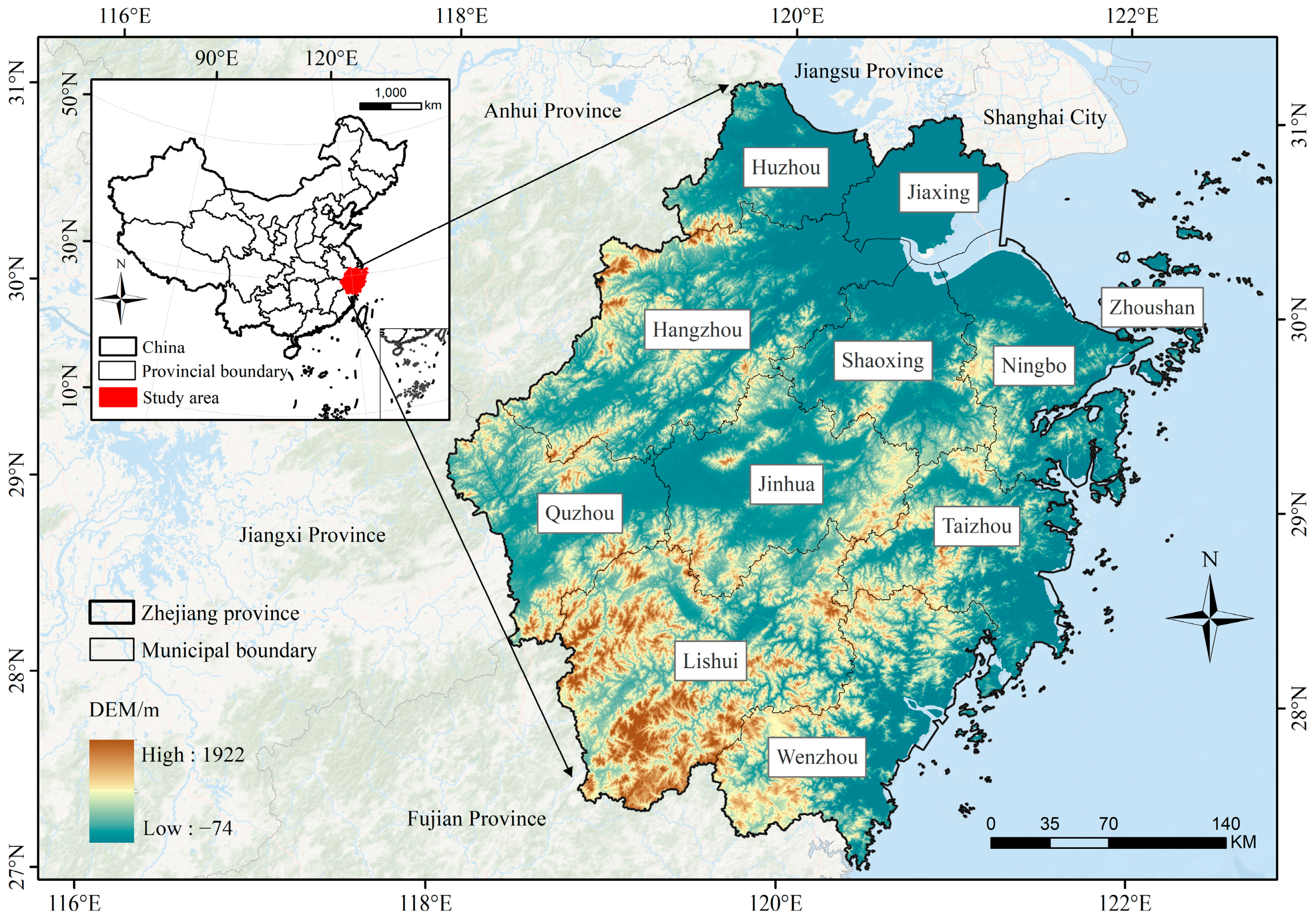
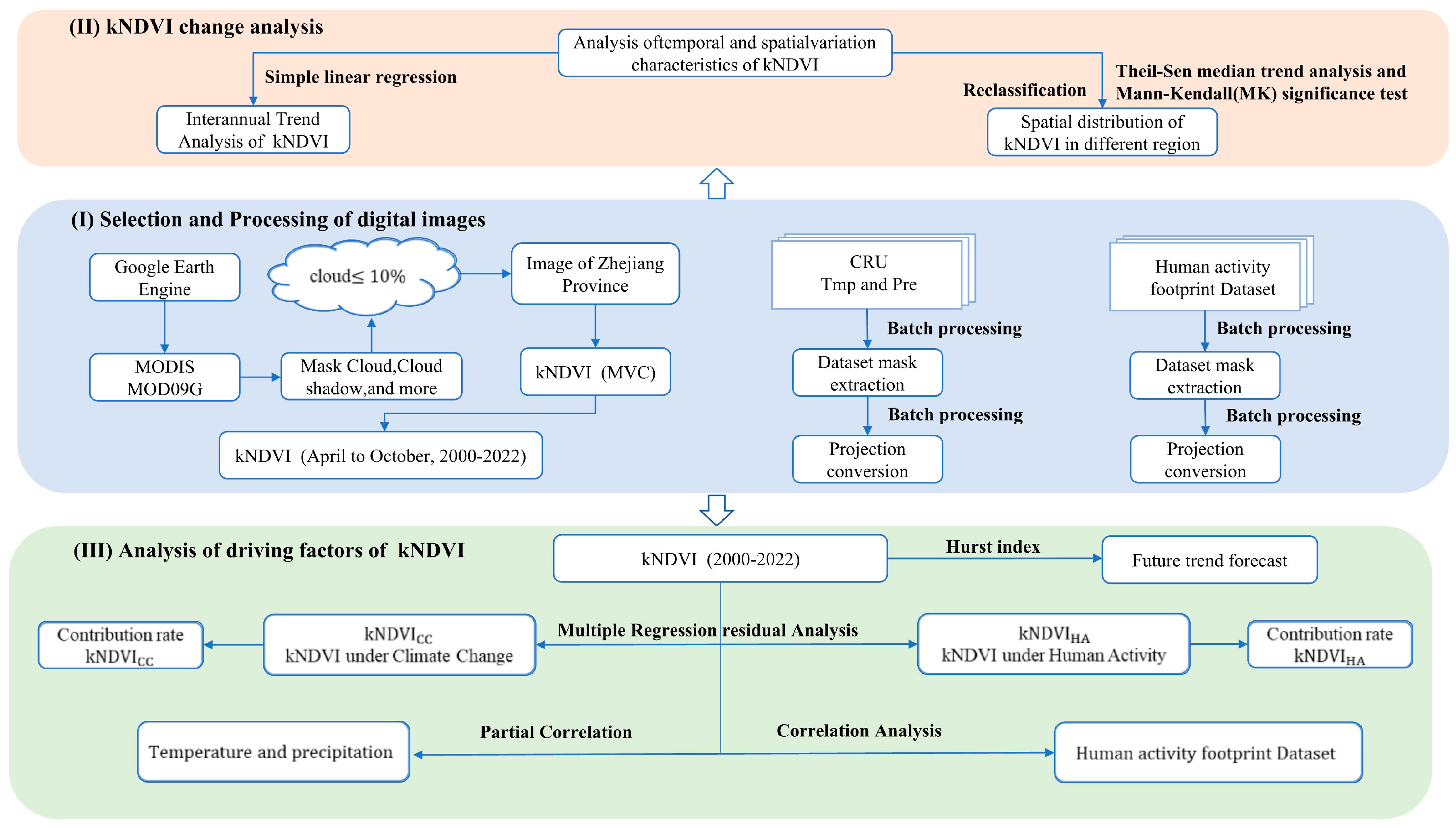




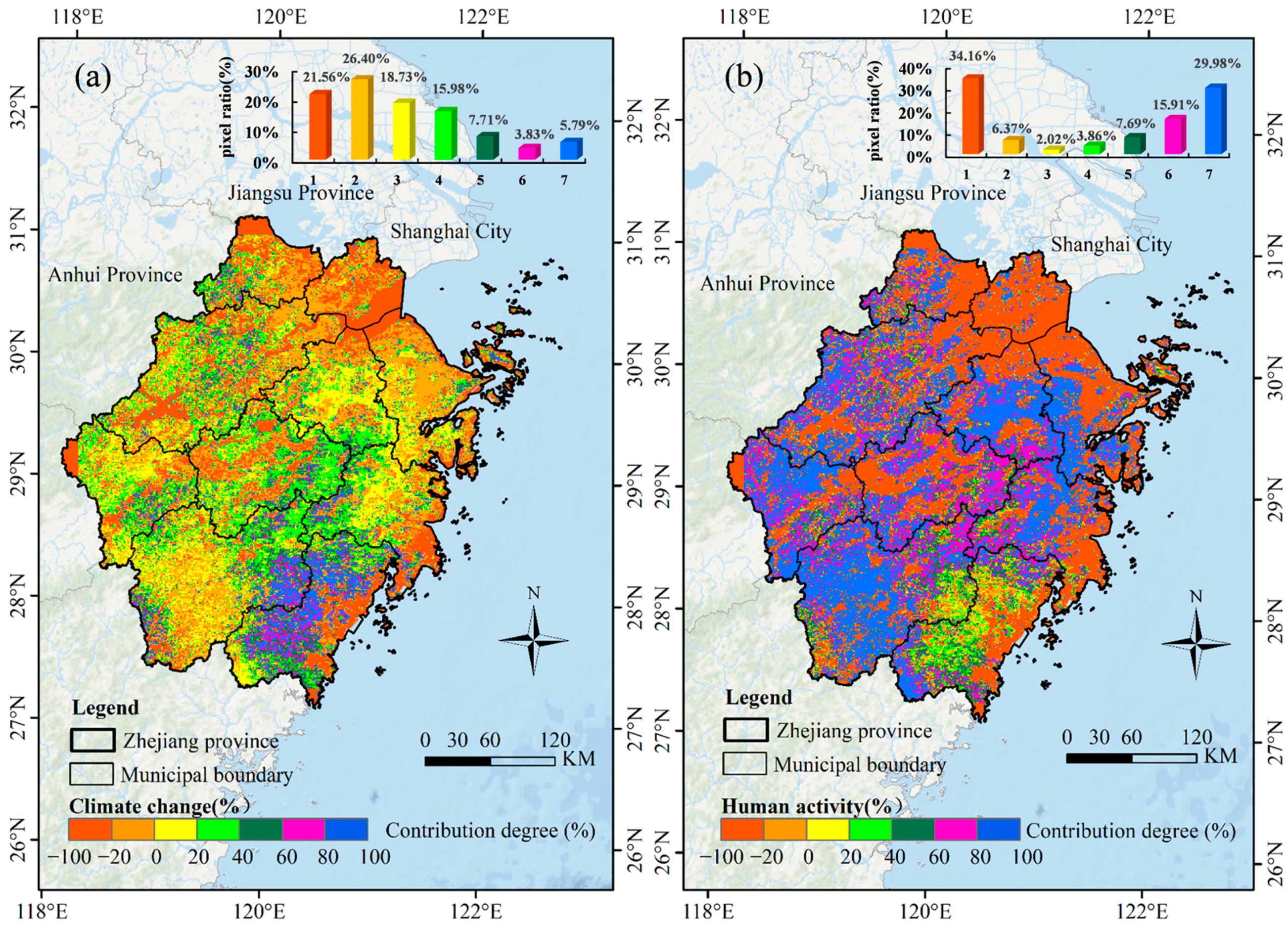

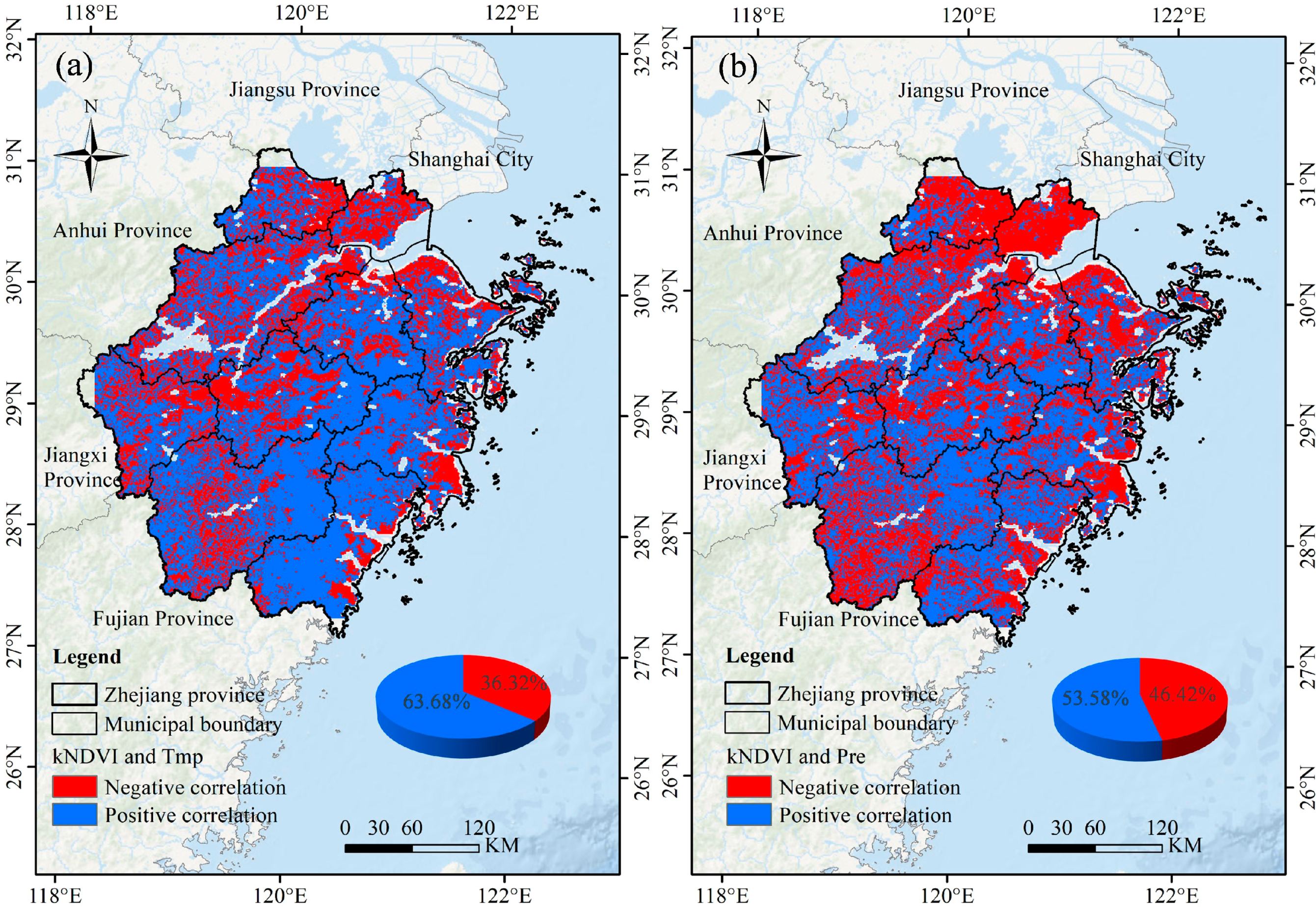
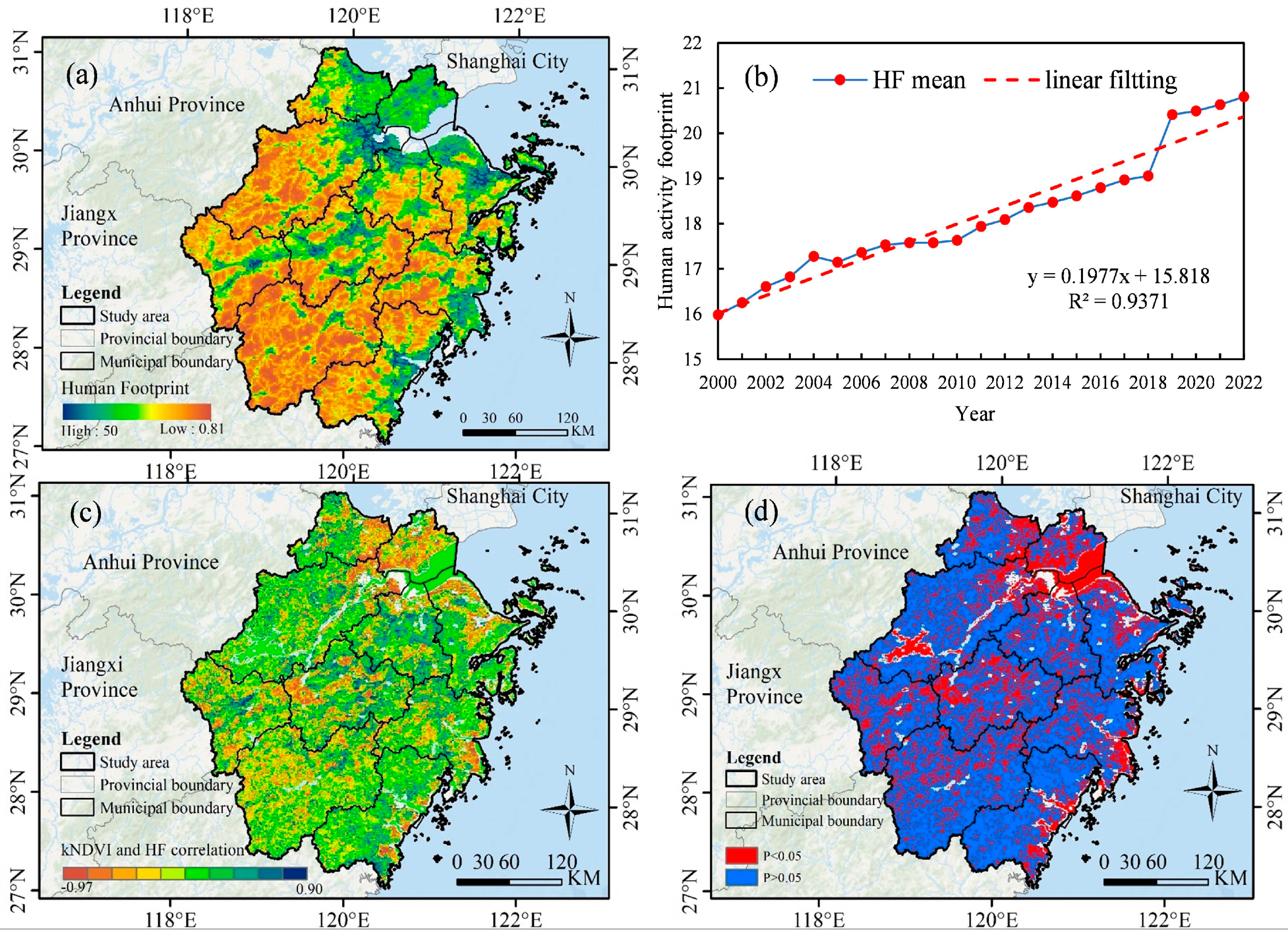
| Dataset | Type | Spatial Resolution/m | Time-Resolution/Year | Data Source |
|---|---|---|---|---|
| MODIS MOD09GA | Raster | 500 | 2000–2022 | https://www.usgs.gov/ (accessed on 15 January 2025) |
| Temperature dataset | Raster | 1000 | 1991–2022 | https://crudata.uea.ac.uk/cru/data/hrg/ (accessed on 15 January 2025) |
| Precipitation dataset | Raster | 1000 | 1991–2022 | https://crudata.uea.ac.uk/cru/data/hrg/ (accessed on 15 January 2025) |
| Human footprint dataset | Raster | 1000 | 2000–2022 | https://doi.org/10.6084/m9.figshare.16571064 (accessed on 15 January 2025) |
| B | G | Trend Features |
|---|---|---|
| B > 0 | G > 1.96 | Significantly increased |
| G < 1.96 | Slightly increased | |
| B = 0 | G = 0 | Basically stable |
| B < 0 | G > −1.96 | Slightly reduced |
| G < −1.96 | significantly reduced |
| Progression Direction | Trends in the Future | Percentage |
|---|---|---|
| Keeping degradation | Strong persistent degeneration | 1.16% |
| Weak persistent degeneration | 7.54% | |
| Previous improved, future will decreased | Anti-strength continuous improvement | 11.82% |
| Anti-weakness and continuous improvement | 35.83% | |
| Previous degradated and will improve in future | Anti-weak persistent degradation | 13.83% |
| Anti-strong persistent degradation | 3.35% | |
| Continuous improvement | Weak sustained improvement | 10.5% |
| Strong continuous improvement | 0.46% | |
| Basically no change | Basically unchanged | 5.35% |
Disclaimer/Publisher’s Note: The statements, opinions and data contained in all publications are solely those of the individual author(s) and contributor(s) and not of MDPI and/or the editor(s). MDPI and/or the editor(s) disclaim responsibility for any injury to people or property resulting from any ideas, methods, instructions or products referred to in the content. |
© 2025 by the authors. Licensee MDPI, Basel, Switzerland. This article is an open access article distributed under the terms and conditions of the Creative Commons Attribution (CC BY) license (https://creativecommons.org/licenses/by/4.0/).
Share and Cite
Chen, L.; Li, C.; Pan, C.; Yan, Y.; Jiao, J.; Zhou, Y.; Wang, X.; Zhou, G. Estimating the Effects of Natural and Anthropogenic Activities on Vegetation Cover: Analysis of Zhejiang Province, China, from 2000 to 2022. Remote Sens. 2025, 17, 1433. https://doi.org/10.3390/rs17081433
Chen L, Li C, Pan C, Yan Y, Jiao J, Zhou Y, Wang X, Zhou G. Estimating the Effects of Natural and Anthropogenic Activities on Vegetation Cover: Analysis of Zhejiang Province, China, from 2000 to 2022. Remote Sensing. 2025; 17(8):1433. https://doi.org/10.3390/rs17081433
Chicago/Turabian StyleChen, Lv, Chong Li, Chunyu Pan, Yancun Yan, Jiejie Jiao, Yufeng Zhou, Xiaoxian Wang, and Guomo Zhou. 2025. "Estimating the Effects of Natural and Anthropogenic Activities on Vegetation Cover: Analysis of Zhejiang Province, China, from 2000 to 2022" Remote Sensing 17, no. 8: 1433. https://doi.org/10.3390/rs17081433
APA StyleChen, L., Li, C., Pan, C., Yan, Y., Jiao, J., Zhou, Y., Wang, X., & Zhou, G. (2025). Estimating the Effects of Natural and Anthropogenic Activities on Vegetation Cover: Analysis of Zhejiang Province, China, from 2000 to 2022. Remote Sensing, 17(8), 1433. https://doi.org/10.3390/rs17081433






